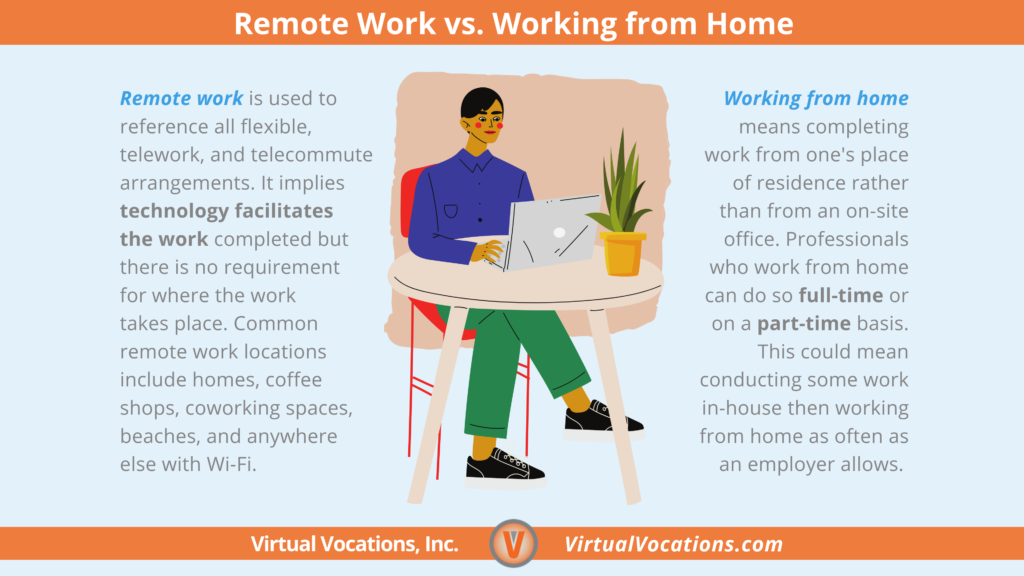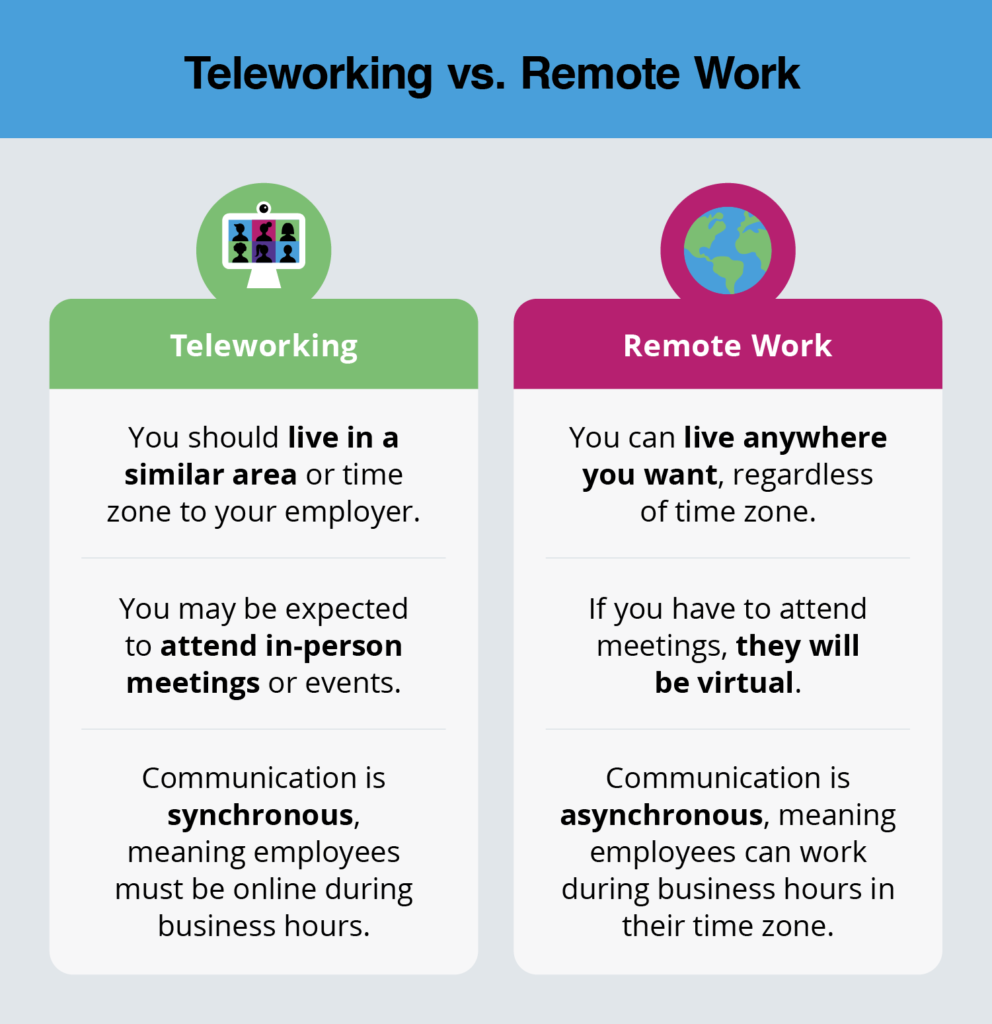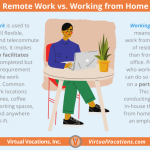Telework refers to working from a remote location, typically from home, while remote jobs are positions that are entirely location-independent. Telework often involves employees working from home for a portion of their workweek, while remote jobs allow employees to work from any location they choose.
Both options offer flexibility and the ability to work outside of a traditional office setting. In recent years, the concept of remote work has gained popularity as technology has made it easier for employees to stay connected and productive from any location.
This shift has led to an increase in telework and remote job opportunities across various industries. Understanding the differences between telework and remote jobs can help individuals make informed decisions about their work arrangements and find the best fit for their lifestyle and career goals.
Telework And Remote Jobs: Unraveling The Terms
Understanding the distinction between telework and remote jobs is crucial in today’s evolving work landscape. Let’s delve into the origins of these terms and uncover common misconceptions associated with them.
Origins Of Telework And Remote Work
The concept of telework dates back to the 1970s when technology enabled employees to work from home. Remote work, on the other hand, gained prominence with the rise of digital nomadism in the 21st century.
Common Misconceptions
1. Telework is the same as remote work: Telework typically refers to working from home, while remote work encompasses a broader range of locations beyond the traditional office setting.
2. Remote jobs lack structure: Contrary to popular belief, remote jobs often offer flexibility and autonomy, empowering employees to manage their schedules efficiently.
3. Telework is isolating: While telework may involve working alone, advancements in communication technology have made it easier for remote workers to collaborate effectively with their teams.

Credit: www.virtualvocations.com
The Evolution Of Work From Home Culture
Over the years, the concept of working from home has transformed significantly, giving rise to various forms of remote work. Let’s explore the differences between telework and remote jobs, and how technological advancements have shaped the modern work landscape.
Early Forms Of Telecommuting
Early forms of telecommuting date back to the 1970s when employees started using telecommunication technologies to work from home. This allowed individuals to connect with their employers and colleagues without being physically present in the office. Initially, telecommuting was limited to specific tasks, such as data entry and customer service, but it laid the foundation for the remote work culture we see today.
Technological Advancements Shaping Modern Work
Technological advancements have played a pivotal role in shaping the modern work landscape. The widespread availability of high-speed internet, collaboration tools, and cloud-based software has enabled individuals to work from virtually anywhere. This shift has given rise to a more flexible work environment, allowing employees to balance their professional and personal lives more effectively.
Defining Telework
Defining Telework: Telework refers to a work arrangement where employees can perform their duties outside of traditional office spaces.
Telework Characteristics
Flexibility: Employees have the flexibility to work from various locations.
Technology: Relies heavily on technology to stay connected with the employer.
Typical Telework Arrangements
- Full-time Telework: Employees work exclusively from remote locations.
- Part-time Telework: Employees split their time between the office and remote work.
- Ad Hoc Telework: Occasional remote work based on specific needs.
Understanding Remote Jobs
Remote Job Characteristics
Remote jobs are positions that allow employees to work from a location of their choosing, typically outside of a traditional office setting. These roles often involve using technology to collaborate with colleagues and perform job duties. Remote jobs offer flexibility in terms of work location and hours, enabling individuals to achieve a better work-life balance. Communication and task management tools are commonly utilized to ensure efficient operations and seamless coordination among remote team members.
Diversity Of Remote Work Opportunities
Remote work opportunities span various industries and professions, including software development, customer service, marketing, and project management. This diversity allows individuals with different skill sets and backgrounds to find remote job opportunities that align with their expertise and interests. Remote work can encompass full-time, part-time, freelance, and contract positions, providing a wide range of options for individuals seeking flexible work arrangements.
Key Distinctions Between Telework And Remote Jobs
In today’s work landscape, telework and remote jobs have become increasingly popular options for individuals seeking flexible work arrangements. While these terms are often used interchangeably, there are distinct differences between the two that can impact an individual’s work experience and the expectations associated with their employment. Understanding these differences is crucial for both employers and employees to ensure successful work relationships and productivity.
Location Dependency
When it comes to location dependency, telework typically involves a set location, such as the employee’s home or a designated telework center. On the other hand, remote jobs offer greater flexibility as employees are not tied to a specific location and can work from virtually anywhere, whether it’s their home, a coffee shop, or a different city altogether.
Flexibility In Work Hours
Telework arrangements often come with structured work hours that align with the traditional 9-to-5 schedule. Remote jobs, however, prioritize flexibility in work hours, allowing employees to set their own schedules and work during their most productive hours. This flexibility can lead to increased work-life balance and job satisfaction.
Employment Contracts And Expectations
For telework positions, employment contracts and expectations may involve clear guidelines on when and where work should be performed, along with specific reporting structures. In contrast, remote jobs typically offer more autonomy, with less rigid guidelines and a focus on results rather than the specific hours or location of work.

Credit: www.virtualvocations.com
Impact On Work-life Balance
Balancing Professional And Personal Life
Work-life balance is crucial for mental well-being.
Telework allows flexibility to manage personal responsibilities.
Remote jobs provide autonomy to structure work around personal life.
Managing Boundaries
Setting clear boundaries is essential for work-life balance.
Telework requires delineating work hours from personal time.
Remote jobs demand creating physical and mental boundaries.
Technological Tools And Their Role
Technological tools play a crucial role in enabling telework and remote jobs, providing the necessary infrastructure for communication, collaboration, and productivity. In this section, we will explore the distinct impact of communication technologies and productivity and collaboration tools in the context of telework and remote jobs.
Communication Technologies
Communication technologies are vital for facilitating seamless interaction between remote workers and their teams or clients. Video conferencing tools like Zoom, Microsoft Teams, and Skype enable face-to-face communication, fostering a sense of connection and understanding. Instant messaging platforms such as Slack and Microsoft Teams facilitate quick exchanges, enhancing real-time communication and problem-solving. Email remains a fundamental tool for formal correspondence, document sharing, and project updates.
Productivity And Collaboration Tools
Productivity and collaboration tools are essential for maintaining efficiency and teamwork in remote work environments. Project management software like Trello, Asana, and Jira help in organizing tasks, tracking progress, and managing deadlines. Cloud storage solutions such as Google Drive and Dropbox ensure seamless access to files and documents from anywhere, enabling efficient collaboration. Virtual whiteboards like Miro and Mural promote visual collaboration, allowing teams to brainstorm and present ideas in a virtual space.
Navigating Challenges In Telework And Remote Jobs
When working in telework or remote jobs, there are specific challenges that individuals may face. Navigating these challenges is crucial for maintaining productivity and well-being.
Overcoming Isolation
Isolation can be a common issue when working remotely. To combat this, establish regular communication with colleagues via video calls or messaging platforms.
Maintaining Productivity And Motivation
Productivity and motivation are essential for success in telework. Set clear goals and create a dedicated workspace to stay focused.
Future Trends In Telework And Remote Employment
Predictions For The Future Workplace
Experts predict a rise in flexible work arrangements in the coming years.
Companies are expected to embrace telework to attract top talent globally.
Adapting To A Global Workforce
Organizations will need to adapt their policies to cater to remote employees worldwide.
Cross-cultural communication skills will become essential for effective teamwork.

Credit: velocityglobal.com
Frequently Asked Questions
Is Teleworking The Same As Remote Working?
Teleworking and remote working are similar concepts, but teleworking specifically involves the use of technology to work from a location outside of the traditional office. Remote working can include teleworking, but it can also refer to working from any location outside of the office, even if technology is not involved.
What Is The Difference Between 100 Telework And Remote Work?
Telework typically refers to working from home 100% of the time, while remote work can include various locations.
Does A Remote Job Mean You Can Work-from-home?
Yes, a remote job allows you to work from home. It provides flexibility and eliminates the need for a traditional office setting.
What Are The Two Types Of Telework?
The two types of telework are fully remote and hybrid. Fully remote telework means working from a location outside the office and having no regular in-person contact with colleagues. Hybrid telework means working from home some days and coming into the office on others.
Conclusion
Telework and remote jobs have distinct differences, even though they both allow people to work from anywhere. Telework is typically done from home, while remote work can be done from anywhere, including coffee shops and co-working spaces. Telework is often a flexible work arrangement, while remote work is a permanent position.
Understanding the differences between these two can help you decide which type of work is right for you. Ultimately, both telework and remote work offer great opportunities for those seeking flexibility and work-life balance.


